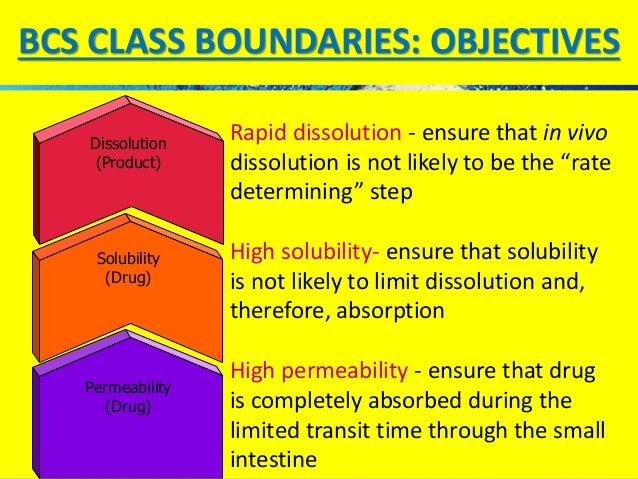Low D o Low A n High D n BCS Class III “if two drug products, containing the same drug, have the same concentration time profile at the intestinal membrane. Mohd Yasir et al /Int.J. PharmTech Res.2010,2(3). CHARACTERISTICS OF DRUGS OF VARIOUS. Contoh Proposal Disertasi Pdf Reader. Class I drugs exhibit a high absorption number and a high dissolution number. The rate limiting step is drug dissolution and if dissolution is very rapid then gastric emptying rate becomes the rate. Drug nanocrystals are known to increase the solubility of Biopharmaceutics Classification System (BCS) class II and IV drugs. SmartCrystals are the second generation.

Contents • • • • • • BCS classes [ ] According to the Biopharmaceutical Classification System (BCS) drug substances are classified to four classes upon their solubility and permeability: • Class I - high, high • Example: • Those compounds are well absorbed and their absorption rate is usually higher than excretion. • Class II - high permeability, low solubility • Example:,,,, • The of those products is limited by their solvation rate. A correlation between the bioavailability and the solvation can be found. • Class III - low permeability, high solubility • Example: • The absorption is limited by the permeation rate but the drug is solvated very fast.

Mission Impossible 4 Hindi Dubbed Movie Free Download. If the formulation does not change the permeability or gastro-intestinal duration time, then class I criteria can be applied. • Class IV - low permeability, low solubility • Example: • Those compounds have a poor bioavailability. Usually they are not well absorbed over the intestinal mucosa and a high variability is expected.
Definitions [ ] The drugs are classified in BCS on the basis of solubility, permeability, and dissolution. Solubility class boundaries are based on the highest dose strength of an immediate release product. A drug is considered highly soluble when the highest dose strength is soluble in 250 ml or less of aqueous media over the pH range of 1 to 7.5. The volume estimate of 250 ml is derived from typical bioequivalence study protocols that prescribe administration of a drug product to fasting human volunteers with a glass of water. Permeability class boundaries are based indirectly on the extent of absorption of a drug substance in humans and directly on the measurement of rates of mass transfer across human intestinal membrane.
Alternatively non-human systems capable of predicting drug absorption in humans can be used (such as in-vitro culture methods). A drug substance is considered highly permeable when the extent of absorption in humans is determined to be 90% or more of the administered dose based on a mass-balance determination or in comparison to an intravenous dose. For dissolution class boundaries, an immediate release product is considered rapidly dissolving when no less than 85% of the labeled amount of the drug substance dissolves within 15 minutes using USP Dissolution Apparatus 1 at 100 RPM or Apparatus 2 at 50 RPM in a volume of 900 ml or less in the following media: 0.1 N HCl or simulated gastric fluid or pH 4.5 buffer and pH 6.8 buffer or simulated intestinal fluid. See also [ ] • • • • • • • References [ ].
Contents • • • • • • BCS classes [ ] According to the Biopharmaceutical Classification System (BCS) drug substances are classified to four classes upon their solubility and permeability: • Class I - high, high • Example: • Those compounds are well absorbed and their absorption rate is usually higher than excretion. • Class II - high permeability, low solubility • Example:,,,, • The of those products is limited by their solvation rate. A correlation between the bioavailability and the solvation can be found. • Class III - low permeability, high solubility • Example: • The absorption is limited by the permeation rate but the drug is solvated very fast. If the formulation does not change the permeability or gastro-intestinal duration time, then class I criteria can be applied. • Class IV - low permeability, low solubility • Example: • Those compounds have a poor bioavailability. Usually they are not well absorbed over the intestinal mucosa and a high variability is expected.
Definitions [ ] The drugs are classified in BCS on the basis of solubility, permeability, and dissolution. Solubility class boundaries are based on the highest dose strength of an immediate release product. A drug is considered highly soluble when the highest dose strength is soluble in 250 ml or less of aqueous media over the pH range of 1 to 7.5.